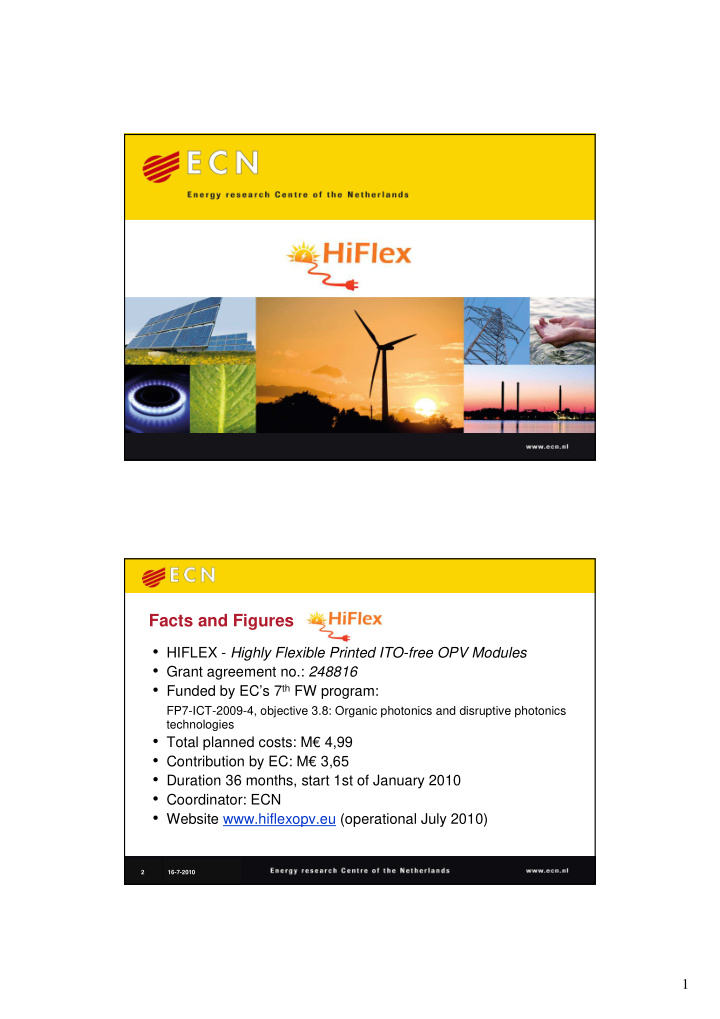



www.ecn.nl Facts and Figures • HIFLEX - Highly Flexible Printed ITO-free OPV Modules • Grant agreement no.: 248816 • Funded by EC’s 7 th FW program: FP7-ICT-2009-4, objective 3.8: Organic photonics and disruptive photonics technologies • Total planned costs: M€ 4,99 • Contribution by EC: M€ 3,65 • Duration 36 months, start 1st of January 2010 • Coordinator: ECN • Website www.hiflexopv.eu (operational July 2010) 2 16-7-2010 1
Consortium HIFLEX Beneficiary Beneficiary name Short name Country Number 1 Energy research Centre of the ECN NL (coordinator) Netherlands 2 Fraunhofer Institut fur Solare ISE DE Energiesysteme 3 TNO Industrie en Techniek/Holst Holst NL Centre 4 Risø National Laboratory for Risø/DTU DK Sustainable Energy 5 The UK Materials Technology MatRI UK Research Institute 6 Dr. Schenk Dr Schenk DE 7 Agfa Gevaert AGFA BE 3 16-7-2010 Organic Photovoltaics Product Generations Courtesy Konarka Technologies 4 16-7-2010 Source: Konarka Technologies 2
Scope of HIFLEX – Organic Photovoltaics (OPV) OPV for mobile and remote ICT applications • Primary critera - Power conversion efficiency - Lifetime - Costs • Secondary criteria to create added value - Power-to-Weight ratio - Mechanical flexibility - Ambient light efficiency - Flexibility module design: product versatlity Schematic of a polymer based Bulk - Technological compatibility Heterojunction solar cell (BHJSC) 5 16-7-2010 Concept of HIFLEX Main driver for HIFLEX: To make OPV suitable for mobile ICT applications: - Use of ITO-free concepts - Roll to Roll production of OPV To enable Competive efficiencies and lifetimes High flexibility Lightweight Courtesy Riso Flexibility in module design Low costs 6 16-7-2010 3
Approach HIFLEX • Application driven R&D • Two concepts that will enable manufacturing of ITO-free OPV Current Collecting Grid (Ag/hc PEDOT) Holst centre/Agfa Wrap Through inverted solar cell Fraunhofer ISE 7 16-7-2010 S/T methodology – overall strategy 8 16-7-2010 4
S/T methodology – project structure R esearch line R&D line D evelopment line 9 16-7-2010 Science and Technology objectives HIFLEX (I) Power conversion efficiency Laboratory single cell (1cm2): - an ITO-free solar cell architecture that achieves at least 90% of the efficiency of “standard” ITO-based solar cells. - A “reference” ITO-based solar cell (benchmark with a maximum power conversion efficiency for the ITO reference cell will be > 7%, and potentially reaching higher efficiencies up to 10%, at the end of the project Module level: - an ITO free OPV module with an area > 50 cm 2 with an efficiency which is > 90% of the single lab cell efficiency (1cm 2 , same cell architecture) based on the active area measured at Standard Test Conditions (1000W/m 2 , AM1.5, 25 o C) - an OPV module processed via S2S or R2R with a total area module efficiency > 60% of the small cell efficiency measured at Standard Test Conditions (1000 W/m2, AM1.5, 25 o C) Ambient light efficiency: - The V oc of the OPV module should amount to > 90% of the V oc for a single lab cell for light intensities ranging from 1000 W/m2 (1 sun equivalent) down to 5 W/m2 (0.005 sun ~approximately 500 Lux). Performance & Technology enabler: - Low cost, solution processable, alternative to ITO based upon PEDOT: PSS with integrated high- conductive grid with a total sheet resistance, R sheet < 60 Ohm/square and transmission >90 %. 10 16-7-2010 5
Science and Technology objectives HIFLEX (II) Lifetime • Development of a low-cost, solution processable, transparent (>80% transmission in the visible), weatherable barrier layer based upon organic inorganic hybrid multilayer materials such as polyacrylate nanocomposites incorporating aligned high aspect ratio nanoclays to encapsulate and seal the active layers with a water vapour transmission rate of ( <10 -6 gm -2 day -1 ) and oxygen transmission rate of < 10 -3 cm -3 m -2 day -1 atm -1 • A lifetime* of > 5000 hours for optimized cells and modules measured under continuous light soaking conditions (illumination by a indoor light source with an illumination intensity equivalent to one sun, cell temperature approx. 55° C). • Establishment of pre-normative test protocols for OPV adapted for mobile and remote ICT applications 11 16-7-2010 Science and Technology objectives HIFLEX (III) Cost reduction • Analysis of critical cost factors for mobile and remote ICT applications and definition of strategies on how to overcome them (target < 10 Euro/Wp) Mechanical flexibility / power-to-weight ratio • Substrate thicknesses with a range of 25 to 100 microns to ensure high flexibility and lightweight • Flexibility sufficient to roll the OPV module with a diameter of 2 cm Module designs • OPV module designs that match the electrical and design requirements of a selection of 3 case study mobile applications in the ICT market. Upscaling and Large Area printing • Development of inline optical tools for quality and process control of R2R to identify errors • Demonstration of OPV integration into flexible electronic circuits Environmental analysis • Life Cycle Assessment including environmental impact analysis to demonstrate improvement against existing technologies 12 16-7-2010 6
Exploitation and dissemination potential • A successful outcome will form the basis of a potentially substantial business opportunity for industrial partners and for spin-outs • Results that belong to the public domain will be disseminated through presentations, publications and website • Workshop with stakeholders • Educational activities 13 16-7-2010 14 16-7-2010 7
Recommend
More recommend